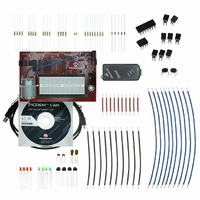DM163035 Microchip Technology, DM163035 Datasheet - Page 21

DM163035
Manufacturer Part Number
DM163035
Description
KIT DEVELOPMENT PICDEM LAB
Manufacturer
Microchip Technology
Type
MCUr
Datasheet
1.DM163035.pdf
(96 pages)
Specifications of DM163035
Contents
Board, Cable, Components, CD, PICkit Programmer
Processor To Be Evaluated
PIC10F, PIC12F615, PIC16F616
Data Bus Width
8 bit
Operating Supply Voltage
1.3 V to 5 V
Silicon Manufacturer
Microchip
Core Architecture
PIC
Core Sub-architecture
PIC10, PIC12, PIC16
Silicon Core Number
PIC10F, PIC12F, PIC16F
Silicon Family Name
PIC10F2xx, PIC12F6xx, PIC16F6xx
Lead Free Status / RoHS Status
Lead free / RoHS Compliant
For Use With/related Products
PIC10F206, PIC16F690, PIC16F819
Lead Free Status / Rohs Status
Lead free / RoHS Compliant
3.1
3.2
© 2009 Microchip Technology Inc.
INTRODUCTION
GENERAL PURPOSE INPUT/OUTPUT LABS
Chapter 3. General Purpose Input/Output Labs
The following labs cover some of the fundamental features of the General Purpose
Input/Output (GPIO) peripherals available on the PIC16F690. As the name implies,
these peripherals are used for general purpose applications that can monitor and
control other off-chip devices. Some PIC
peripherals on-chip including the PIC16F690 used in the following labs. Therefore, the
PORTx naming convention is used. Available ports on the PIC16F690 are:
• PORTA
• PORTB
• PORTC
Reading through the data sheet highlights some of the unique characteristics associ-
ated with each port and the reader is encouraged to explore these in greater detail once
comfortable with the labs in this user’s guide. The labs will focus on two of the port
peripherals: PORTC and PORTA. Labs will be naturally divided into two sections since
these are General Purpose Input/Output peripherals:
• Output Labs
• Input Labs
Output labs will introduce the reader to concepts necessary to configuring these periph-
erals for output to off-chip devices using applicable registers by lighting 8 LEDs con-
nected to the PORTC pins
The Input labs will then add a push button interfacing to one of the PORTA pins to high-
light concepts necessary for configuring these peripherals to receive information from
off-chip devices. Finally, interrupts will be used to optimize the application for different
purposes.
• Output Labs:
• Input Labs:
- Lab 1: Light LEDs
- Lab 2: Flash LEDs (Delay Loop)
- Lab 3: Simple Delays Using Timer0
- Lab 4: Rotate LEDs
- Lab 5: Adding a Push Button
- Lab 6: Push Button Interrupt
- Lab 7: Push Button Interrupt-on-Change
- Lab 8: Using Weak Pull-ups
PICDEM
TM
BOARD USER’S GUIDE
®
microcontrollers have multiple GPIO
LAB DEVELOPMENT
DS41369A-page 17











